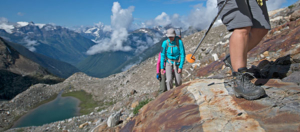“Always break-in your boots before going hiking in them.” That’s the wisdom, but in practice we often go hiking in new boots. Sure, wearing them around town, walking the dog, or even doing chores around the house is a good idea, but in practice we often don’t find time to break in our boots.

However, with the recent crop of lightweight, soft, forgiving boot designs, breaking in hiking boots isn’t as brutal as it once was. The synthetic materials that are part of the vast majority of today’s hiking shoes don’t “break-in” like all-leather boots anyway. If you have a poor fitting boot, it will probably never fit quite right, but if you get a pair that fits your feet, you can often hike comfortably from day one. The fleet of high-end hiking boots (shown above) at CMH Summer Adventures, with a few brands for different shaped feet, fits virtually everyone, from the first step into the helicopter until the last step out of the tundra.
I’ll admit, I’m terrible at the break-in process, and often end up with a new pair of boots right before a trip to the mountains. Thanks to too many trips with new boots, I’ve learned some tricks for making new boots – or any shoes for that matter – feel better while hiking.
The key to comfort is how you lace the boots.
First, I like to lace the boots as tightly as I possibly can for a short time before going hiking, and then I lean hard on them in every way I can imagine flexing them in the mountains. This seems to provide an accelerated break-in period, giving the shoes a chance to conform slightly to my feet.
From then on, I take the time to adjust my laces depending on terrain:
- For flat terrain, try for an even lace tension from toe to bow.
- For uphill hiking, tighten the upper part of the boot while leaving the toebox loose. This helps prevent heel rubbing since the ankle is held snug and the toes can relax and flex comfortably with the hill.
- For downhill hiking, lace your boots tight around the forefoot to keep your toes from banging into the end of the boots as well as to minimize slipping and friction on the soles and sides of your feet. Leave the ankles loose so you can articulate easily on the steeper sections.
- For rugged, uneven terrain, start with snug lacing throughout the foot, and adjust as needed – as soon as needed – based on comfort.
Common trail wisdom is that you should use some kind of blister kit before getting blisters, but even better, you can often avoid the blister kit in the first place if you adjust your laces at the first sign of rubbing. Tying a simple extra twist in the lace at the point you want the tension to change will keep the shoes laced how you’d like them to be, and many modern hiking boots have a lace cleat that is designed to hold tension differently on the upper and lower part of the boot.
Lacing for different terrain is a big help, but the ultimate pleasure for your feet is stopping for a soak in a cold mountain stream. I have no proof, but observations reveal that hikers who stop to soak their feet are happier, make more money, have better marriages, take better vacations, and generally enjoy life more thoroughly…
Photo of heli-hiking at CMH Bugaboos by Topher Donahue.